Late ice in much of the north country means it’s time to panfish, and if you are like me, you’ll find your efforts going into catching more and bigger crappie. Hard houses are off most lakes and the weather makes it easy to move. Ice fishing pressure is at a minimum and the lake is yours to conquer. When it comes to ice fishing crappie there is no better time.
So what constitutes late ice? For me, it’s March. The days are getting longer, warmer, and lake oxygen and nutrients start to change. Between now and open water, panfish patterns will start to transition rapidly.
THE KEY IS TO KEEP THINGS SIMPLE
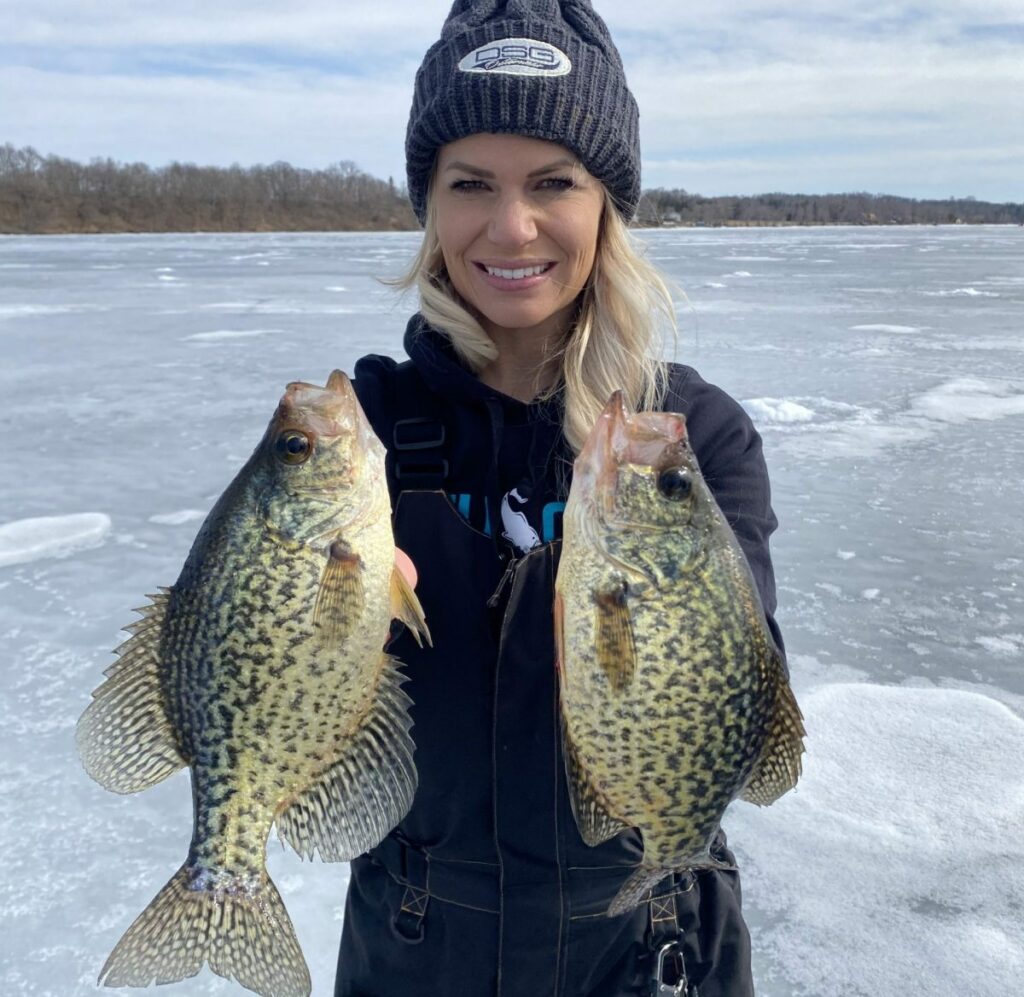
Before I start breaking this down, let me preface with the fact that I’m an average angler. So when I write about fishing, I write from that perspective. I try to keep it simple because I fish simple, and if I can easily find fish this this time of year so can you.
That’s why I love late ice. It is some of the most simple fishing you can experience. Crappie is the one species and late ice is the one time of year I think anyone can take advantage of.
That’s why I decided to share my entire strategy below. Let me help you find and catch more fish during late ice.
1. THINK FOOD & OXYGEN FOR LATE ICE CRAPPIE
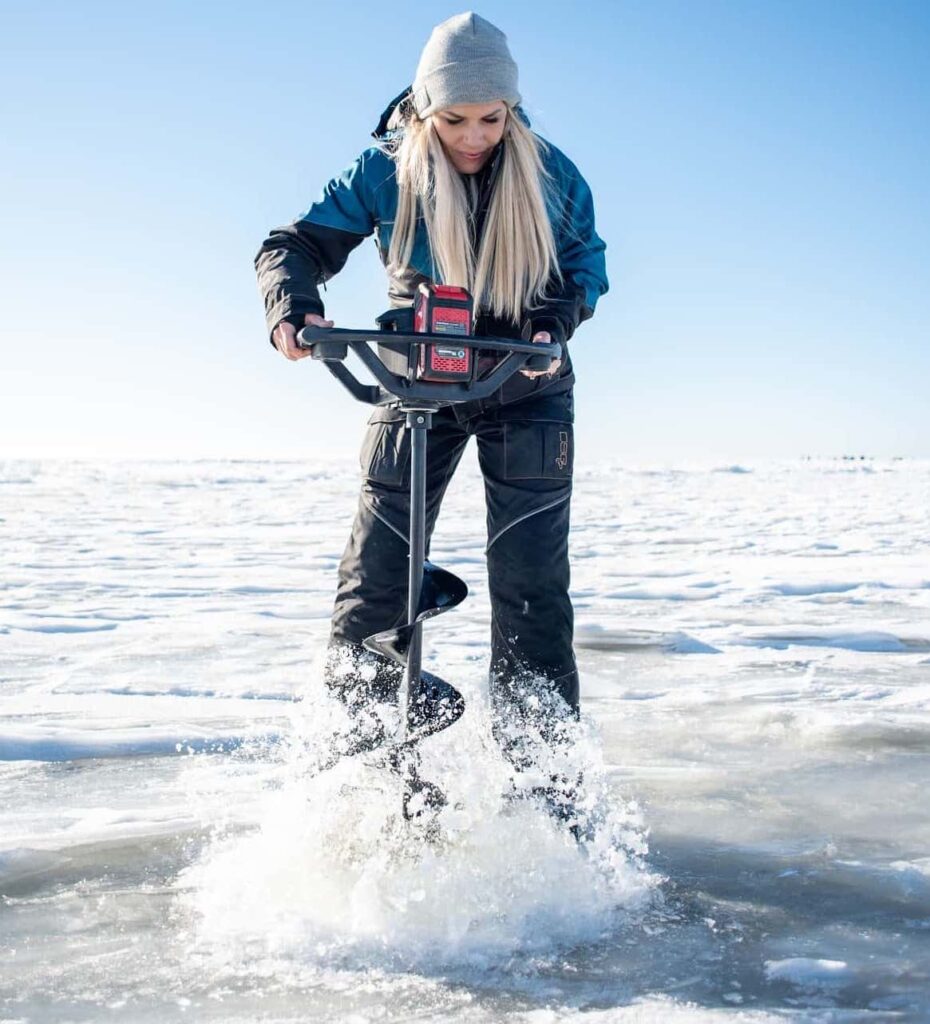
Step one is to think about the basics: fish need food and fish need oxygen. You can typically find the food where there is oxygen. Pretty simple. So where is there food and oxygen during this time of year?
For me it’s typically three places:
- Deep Water (basins, bowls): Typically earlier in the season before shorelines start eroding and sun penetrates the ice.
- Inlets (rivers, creeks, springs, etc..). Where there is fresh water, there is fresh oxgyen and there is food. Look for fish here.
- Find Transition Areas. As spring starts to really penetrate the snow and ice, fish become more active in the shallows during the day. Look for shallow bays next to deep bowls and inlets and you will find fish. In these situations later one, try shallow during the day and deeper during the night.
LOOK FOR OXYGEN
Still Try Basins
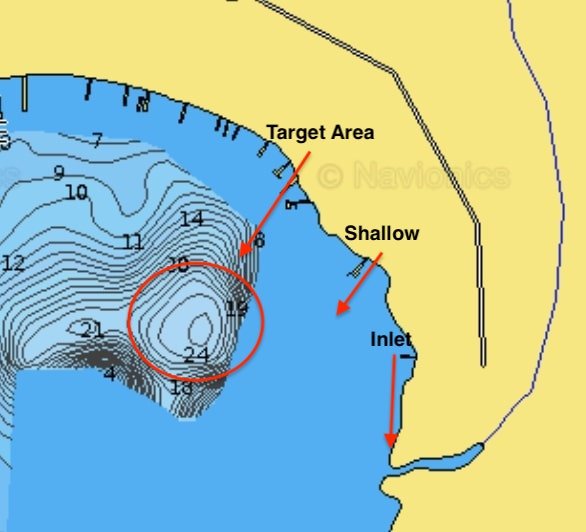
Despite what many people tell you, I still try deep water. I’ve tried punching weedlines time and time again, and much of the time I find nothing but dead weeds (not always but often). So for the most part, I save time and still target bowls and basins (much like I do during mid winter). When I want to save energy and time, I target them in the evening when they head there to feed.
There is still food in these locations, and I’ll find them suspended across the entire column. Some people say go straight to shallow, but I almost always still have luck finding these fish in the deeps – even right after ice out and particularly in the evenings.
Not all lakes have sources of freshwater (which brings in oxygen and often bait). However, many do – and when this is the case, focus on these places (just make sure they are safe). Streams bring in the fresh oxygen, and fish will congregate in these areas. Oftentimes they will be around these areas during the day and transition into the bowls of the lake at night. The best crappie fishing I’ve ever experienced has been when they transition to these areas. Fresh water to a deep bowl is KEY for trophy crappie success this time of year. If you find this you’ll find the fish.
Watch Transitions as the Season Goes On
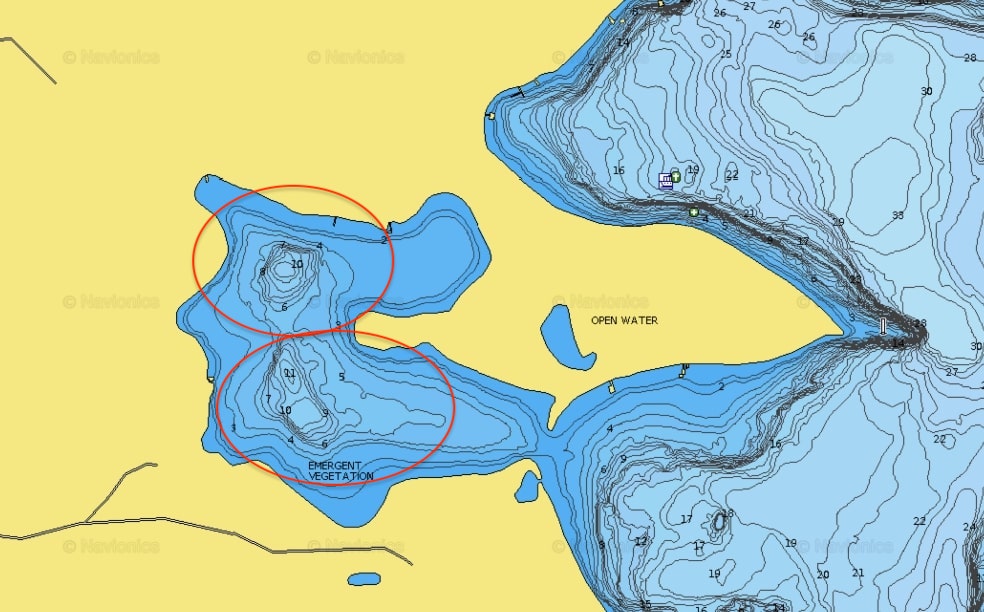
These fish can often transition during the day. The closer to ice out, the more I’m willing to try shallow areas. Often times I find them right between where they stage in the spring (open water) and that deep water they congregate to all winter. However, I can’t emphasize enough that when in doubt – still go deep.
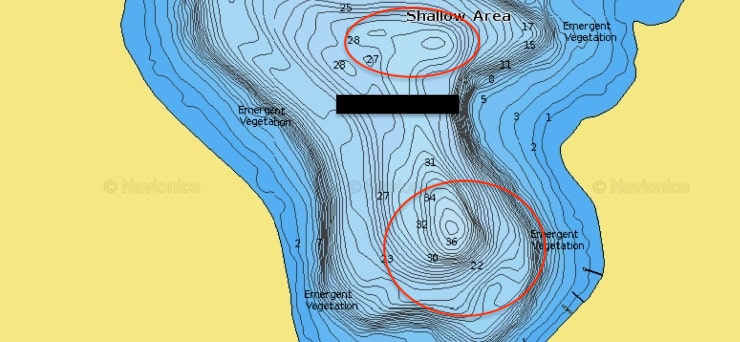
LOOK FOR FOOD
Zooplankton
Zooplankton comes out at night, often clouding your graph to the point of not seeing your lure. The plankton hugs the bottom early on and works up through the column as the night goes on. Crappie congregate here still because it’s easy food. If you see plankton, there is a good chance you will see fish. It’s tough to target them through this but it IS doable. However, the best thing to do is target them in the basin and across the break line (into the basin) before the plankton start to rise through the column. If you’ve seen plankton down there, I guarantee crappie will be headed there at some point to feed.
2. PUNCH HOLES & LOOK FOR SUSPENDED MARKS
Just like in my ice fishing guide for crappie, I still recommend doing some work. Punch some holes and look for suspended activity – that’s crappie. They are hands down the easiest fish to identify with a traditional flasher, let alone live sonar.
If you are really setup, take live sonar (Garmin Livescope, Mega Live, etc..) and jump into forward mode. Fish are moving fast this time of year so you are going to want to rely on your traditional flasher to move but your livescope to search.
Once you detect them, then punch of holes across the target area. Have one person pointing to them from live imaging and the others running around with portable flashers staying on top of the fish.
As for evenings and overnights.. don’t be afraid to setup where you mark. They won’t stay below you, but they will continuously cycle through so make sure you are down there when you do.
3. USE HEAVIER BAITS
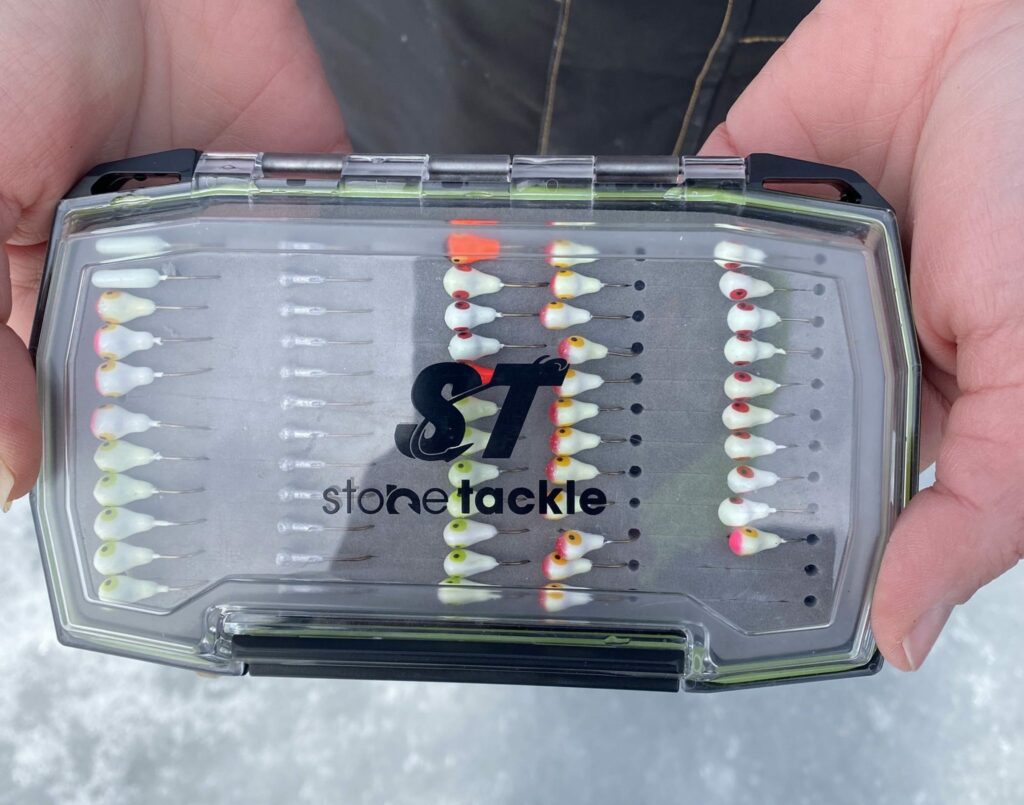
I talk a lot about the benefits of lead jigs, especially the slower fall rate and less noticeable bite resistance during the heart of winter. However, this time of year the bite is often much more aggressive and fish are moving so much quicker. It’s in these moments where you NEED a heavier spoon or use a tungsten jig.
The key is to find something that will get down there quick. You won’t have nearly as much time to drop down, so make sure you are setup with heavier baits so you can keep your lure in the water that much more often.
4. PLASTICS CAN BE KEY
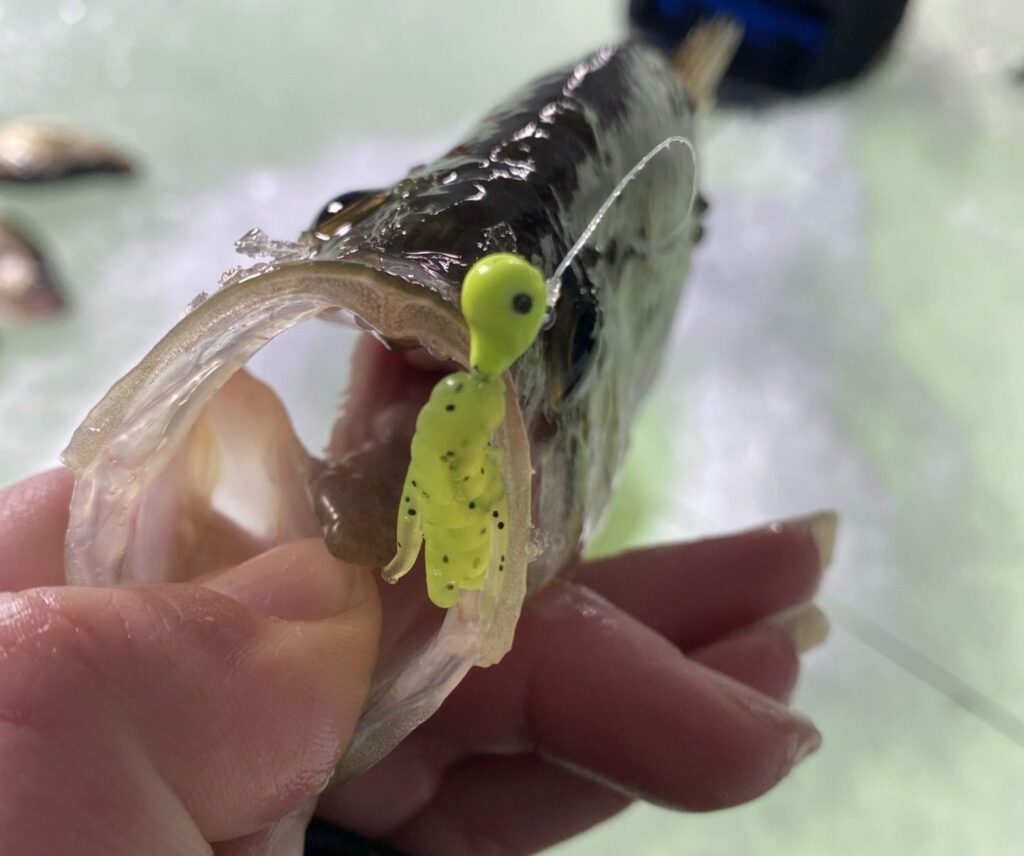
The bite is usually hot this time of year, so it’s less about using something finesse and more about making sure you have bait on and getting down the ice hole fast enough (and especially not wasting time constantly re-baiting). That’s why I highly recommend using plastics during late ice. They are tougher, heavier, and let you keep your line in the water that much longer. It also gives you confidence that you haven’t lost your bait after missing a few hook sets.
That’s why when plastics work they are tough to beat for hardcore crappie fishing.
I recommend Bobby Garland Itty Bitty Swim’R (code nicole15 for a discount) and the Freedom Baitz sidewinder for your late ice crappie adventures.
5. MORE AGGRESSIVE CADENCE
I mentioned this earlier but I’ll discuss it again. Plankton are still going to be a factor at night. I’ve spent many March and April nights targeting fish over plankton and the bites been on fire. When you see plankton congregate on your sonar, the best bet is to simply jig above it. Sometimes you CAN do a steady raise through it (something I advocate heavily for during mid ice) but this time of year go aggressive. Whether you are fishing during the day or overnight a stronger cadence can go a long ways in turning over more fish this time of year.
6. ALWAYS MARK YOUR LATE ICE CRAPPIE SPOTS
I mark every. single. spot. These fish typically don’t travel far throughout the year but instead make small moves, and knowing these small moves not only set you up for success the next day, but season after season.
Always, always mark your spot and take notes. If you plan on fishing repetitively, it’s your best bet at success. Be sure to use Navionics or LakeMaster (now also available on your phone) to mark your most active spots – while also taking note of the time, baits you used, and behavior. If you want to get into a consistent bite, the best thing you can do is start where you left off. Pay attention to variables and take notes, it won’t only help you find more fish the next week, but on new bodies of water as well.
7. TARGET THE TROPHIES
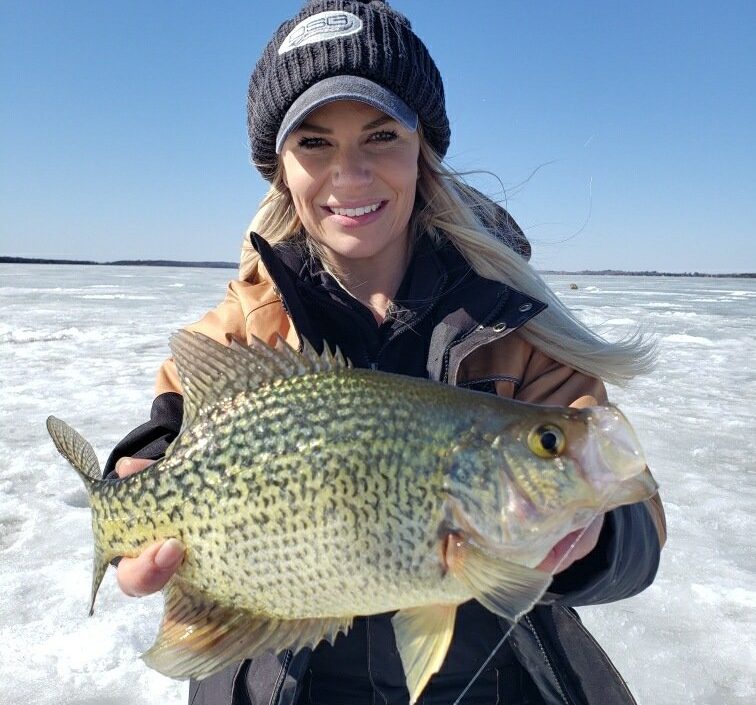
Trophy fish fly solo, often. I tend to find them high flying above the school almost all of the time. So jigging high brings you 2 benefits: 1 it is initiating competition since crappie often eat up and 2 is being in the target zone when that trophy cruises by. You won’t have much time this time of year, so jig high.
EXACTLY WHAT A DAY ON LATE ICE LOOKS LIKE FOR ME
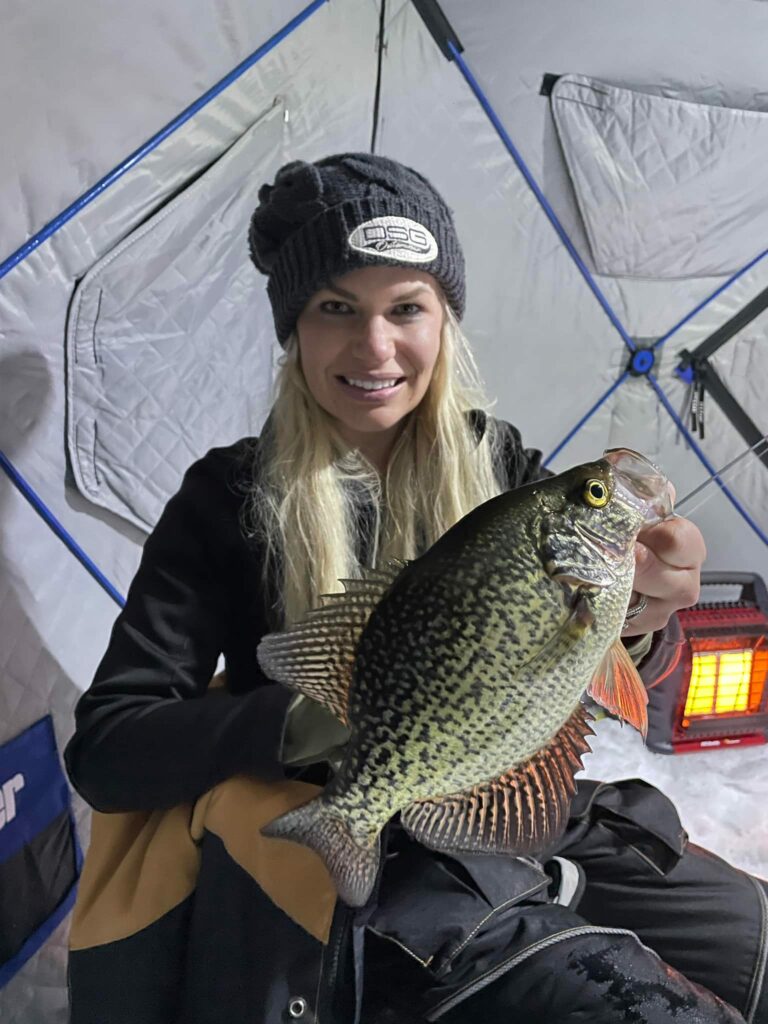
My Late Ice Setup:
- Lindy Tungsten Toad (code nicole15)
- Bobby Garland Itty Bitty Swim’R
- Freedom Baitz Sidewinder
- Tuned Up Custom Rods Bullwhip
- Berkley Vanish
THE KEY IS TO KEEP THINGS SIMPLE
- If targeting a new lake, I evaluate the bowls/basins and inlet/outlets on a Lake Map. I will also evaluate survey reports.
- Fish ANYTIME. BUT, if you are short on time, plan to be at the lake towards evening. The bite window gets better towards dark in most situations (not always but often).
- Pop holes across the basin/breaklines. The best fishing I find is typically a basin near an inlet. However, in a small lake, most fish will be congregated to the deeps of a bay this time of year.
- Crappie suspend. Find suspended marks and you have found the fish.
- As night rolls in and I see plankton, I instantly switch to using minnows.
- Crappie tend to roam the same areas over and over again this time of year. If you want to bounce around after them after in the dark then go for it. However, I set up at this point and pick them off as they continuously roam through.
- I rely on heavier and more durable baits – usually tungsten and plastics. This allows me to get down the bait quick and stay down longer.
Crappie fishing doesn’t have to be difficult. In fact, find some bowls, mark some fish and take notes. The best way to get good is to practice. So fish as much as you can and learn from every trip.




